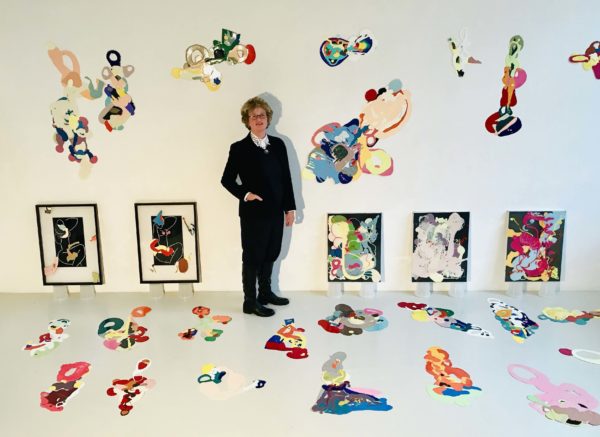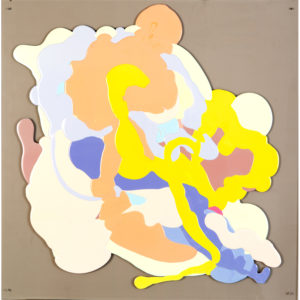
Nederlands | English
Cecile van der Heiden
In haar recentere werk zijn de beelden niet meer gevangen in een kader maar losgekomen van het traditionele platte vlak. De vormen hangen als zelfstandige constellaties aan de muur. Heftige bewegingen gecombineerd met stille vormen. Tijdens het gieten lijken ze spontaan te zijn ontstaan. Het tegendeel is waar, de kunstenaar kiest een duidelijk kleurenpalet. De beweging wordt gestuurd en op het juiste moment tot stilstand gebracht. Binnen het palet zijn grote contrasten en is visuele afwisseling aanwezig. De vitaliteit en monumentaliteit gaan in de laatste werken hand in hand.
Met directheid en durf, actie en reactie zoekt Cecile van der Heiden iedere keer weer de grenzen op. Dat is haar avontuur.
Vroege tekeningen (1979-1984)
De vroege tekeningen zijn lineair opgezet. De lijnen zoeken zich hun weg over het veld en vormen gaandeweg een imaginair labyrint Met verschillende materialen zoals grafiet, oilsticks wordt een grillig effect bereikt. De tekeningen bevinden zich in verschillende collecties waaronder het Groninger Museum. Op de Internationale Jeugd Biënnale in Parijs werden deze tekeningen getoond. De maten varieren van 70*100 tot 150*250.
Latere tekeningen en schilderijen (1984-1990)
Het werk ontwikkelt zich van lineaire composities naar werken waarbij de achtergrond en voorgrond in kleur om elkaar strijden. Door een tweejarig verblijf in New York City wordt de invloed van deze wereldstad zichtbaar. De vitaliteit wordt hoofdonderwerp van haar kunst. Het werk werd voor het eerst getoond bij galerie The Living Room en later in de galerie van Riekje Swart te Amsterdam. Werken uit deze periode werden gekocht door het Boymans van Beuningen te Rotterdam en het Centraal Museum in Utrecht, Groninger Museum in Groningenen en Museum Helmond in Helmond, en is vertegenwoordigd in vele openbare en particuliere collecties.
Vroege plastics (1990-1998)
Tijdens haar verblijf in New York City paste Cecile een nieuwe techniek toe. Zij combineerde glanzende folies, die ze gebruikte als achtergrond in perspex boxen. Met plastic fabric paint werden deze boxen geschilderd. De verf werd direct uit de tube gespoten en in de traditie van de pattern paint ontstonden grillige asymmetrische abstracties waarbij de kleuren elkaar ontregelen en complementeren tegelijkertijd. Deze werken werden getoond bij Galerie Swart, Landon Gallery New York City, Gallery Eight Floor en New York City.
Vloeibare plastics (1998-heden)
Een twee componenten plastic ligt aan de basis van de huidige ontwikkeling van het werk van Cecile van der Heiden. De vormen worden over elkaar heen gegoten en in tegenstelling tot de vroege plastics is het mogelijk grote maten te realiseren. Het werk kent geen kaders en onderzoekt de grenzen tussen beeldhouwkunst en schilderkunst. De werken hangen als losse constellaties aan de wand en laten zich zo combineren tot kleurige installaties. Recente tentoonstellingen waar deze werken te zien waren: Tijdens de Biënnale van Noord-Holland in de Vishal te Haarlem, Galerie de Expeditie te Amsterdam en Galerie Rob de Vries te Haarlem.

Beau, 2002
65 x 65 x 0,7
Nederlands | English
Cecile van der Heiden
In her recent work the images aren¹t constricted by a frame, but are set free from the traditional flat surface.These shapes hang as independent constellations on the wall, showing contrasting wild movements with quieter forms.They seem to emanate spontaneously from the process of pouring liquid plastic.However, what went on is quite the opposite.
Initially the artist selects her colours with care. Then she carefully directs the pouring, controlling the movements and the right moment to stop.This results in flowing forms with strong contrasting colours and great visual diversity where vitality and monumentality blend together.
Cecile van der Heiden directly and courageously challenges her boundaries, acting and reacting, That’s the adventure.
Early drawings (1979-1984)
The early drawings are linear in character. Lines meander on the surface and create gradually an imaginary labyrinth. Erratic effects are achieved with differing materials such as graphite and oilstick.
These drawings are now in various collections, including the Groninger Museum in the Netherlands.They were also exhibited at the International Youth Biennial in Paris.The sizes vary between 70 x 100 cm and 150 x 250 cm.
Later drawings (1984-1990)
The work developed from lineair compositions to images in which the colours in the background and foreground compete with each other. Here, the influence of a two year stay in New York City becomes apparent.The vitality of this city becomes the main subject of her art. These works were shown for the first time in gallery The Living Room and later at gallery Riekje Swart, both in Amsterdam. They were acquired by the Boymans van Beuningen Museum in Rotterdam, the Centraal Museum in Utrecht, the Groninger Museum in Groningen and Museum Helmond in Helmond, all in the Netherlands. They are also represented in many public and private collections.
Early plastics (1990-1998)
During her stay in New York City,Cecile van der Heiden adapted new techniques.She combined shining foils and used them as backgrounds in perspex boxes.These were painted with plastic fabric paint, directly squeezed from the tube.This resulted in erratic asymmetrical abstractions with both contrasting and complementary colours in the tradition of Pattern painting.These works were exhibited at gallery Swart in Amsterdam, London Gallery in New York City, gallery Eight Floor and New York City.
Liquid Plastic (from 1998 onwards)
Plastic formed from two components is a the basis of the latest developments in Cecile van de Heidens work. Different shapes of plastic are poured on top of each other and in contrast with the Early Plastics making,it now possible to execute large pieces.These forms have no boundaries and go beyond the limits of painting and sculpture.They hang as free constellations on the wall and can be combined into colourful installations. Recent exhibitions of these works include : the Noord Holland Biennial at the Vishal in Haarlem, gallery De Expeditie in Amsterdam, and gallery Rob de Vries in Haarlem.